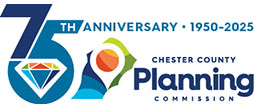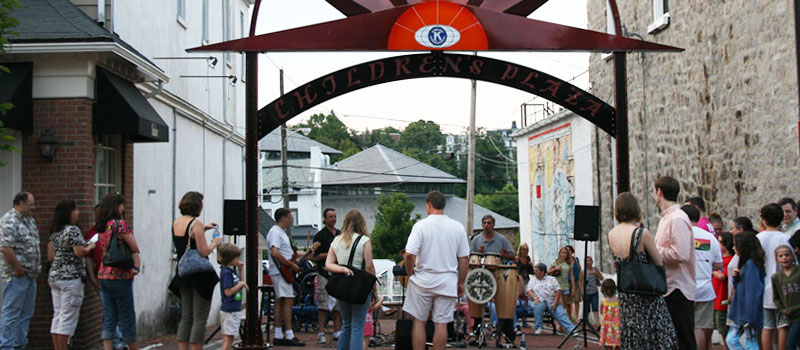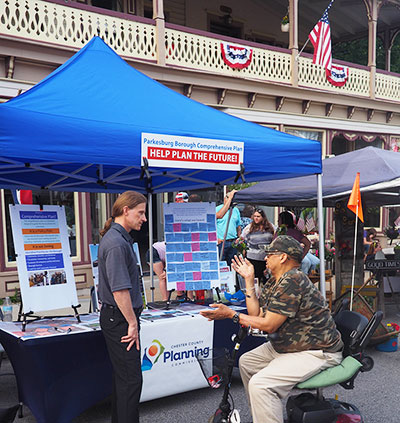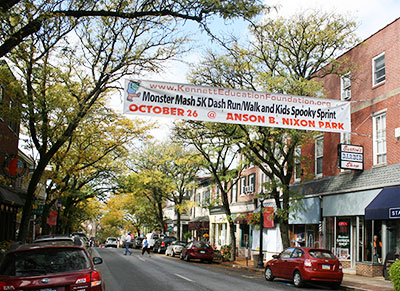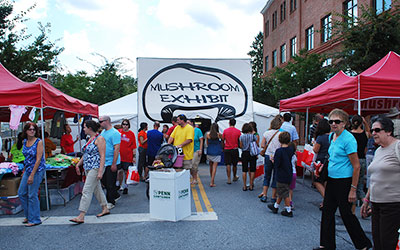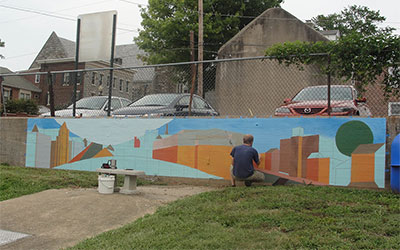Directly engaging the community is an important component to solicit input and for transparency.
How it Works
A vital main street is an icon of a healthy community, and a foundation for economic health, local quality of life, and community pride. A promotional strategy can help municipalities attract customers, investors, and businesses to the main street. Promotional activity can be necessary for competitiveness — the public will visit the main street that they are hearing about, or visit main streets hosting an event of interest.
Main street promotion differs from individual business promotion as it attracts visitors, investors, and businesses to the full area as opposed to an individual business. Main street promotion acts in a similar manner to how a community farmers' market is promoted — the whole market is advertised rather than an individual vendor.
Promotional activities can include outreach, mapping, events, and festivals, as well as discounts and advertisements. Municipalities can partner with relevant organizations to promote main streets by creating a promotion strategy, implementing promotional activities, providing infrastructure for activation activities (such as public spaces, electricity, and waste removal), and creating processes and ordinances that allow for activation activities.
Promotion is a key component of an overarching main street program, along with design, economic vitality, and organization.
Benefits
Business Support
Promotional activity draws visitors and patrons for businesses.
Business Attraction
Main street promotion can help attract new businesses by increasing business patronage, creating a positive image of the area, and informing new businesses of available properties.
Revenue
Increased visitors will generate revenue for municipalities through increased taxes, parking fees, and permitting fees.
Community Building
Special events not only draw patrons from outside a community but also create community interaction and collaboration, enhance community pride, and celebrate the unique aspects and history of a community.
Historic Preservation
Main street promotion can increase knowledge, appreciation, and visitors to these historic resources, which often help form a unique sense of place on a main street.
Promotion of events is critical to their success.
Get Started
To begin, municipalities should identify their current capacity to carry out promotional activities in an ongoing manner. Municipalities should judge whether they have the staff time available internally, the potential organizational partners to help support, and the budget available to hire professional assistance. Where the current capacity is unavailable municipalities should consider how to build capacity for promotion.
Promotional activities will be most successful when involving multiple stakeholders. When possible, municipalities should partner with organizations such as local main street organizations, business associations, Business Improvement Districts (BIDs), chambers of commerce, historical societies, realtors, event organizers, local businesses, and tourism bureaus to lead and implement promotion of main streets. If partnerships are unavailable, municipalities can consider forming a committee or engaging community members to lead promotional activities. Municipalities should consider municipal officials, local business owners, local business organizations, residents, and other stakeholders as partners to lead promotional activities.
Next, a promotional strategy should be established. The promotional strategy should be catered to the unique assets of the main street. The strategy should include the type of promotional activity, target audience, timeframe, cost, priority, stakeholders, tasks, and responsibilities. Methods to evaluate the success of promotional activities should be built into the plan. Promotional strategies should be updated annually.
Promotional activities vary, and municipalities should utilize a combination of promotional activities to promote their main streets.
Branding
Branding can help create and convey the identity of a main street. Creating the branding tools first will help to convey a consistent identity and implement future promotional activities.
Logo: A logo can help to quickly identify a main street. A logo should be able to be used in a variety of settings, and full color, black and white, horizontal, and vertical options should be created.
Style Guide: A predetermined set of colors and fonts can help to ensure promotional materials maintain a consistent identity. Style guides can also identify correct logo usage.
Photography: Creating a set of photos of the main street can make future promotional activities easier. When using photography found online, check usage rights to ensure photography can legally be utilized.
Messaging: Developing a set of talking points can ensure marketing remains consistent. Drafting unique text describing the main street assets can then be used in materials that reference the main street.
Online Marketing
Online marketing methods often provide lower cost options of reaching multiple people. Settings can be adjusted to reach and "follow" target audiences. Online marketing also has tools built in to help analyze promotional activities' levels of success. Online marketing will not reach all people, such as those without access to a computer or phone, so additional methods should be used as well (see Print and Media Marketing, below).
Websites: A website can help visitors and potential businesses find a main street and learn about businesses, events, and available properties. Ensure the information provided on a website remains up to date to best inform the public. A website with minimal information can be easier to maintain.
Newsletters: Newsletters can keep potential visitors and businesses actively engaged by providing up-to-date information. Programs such as Mailchimp, Canva, and Constant Contact can help to make professional quality mailings and manage contact lists.
Social Media: Posting on social media sites such as Facebook, Instagram, Pinterest, TikTok, and Youtube can help potential visitors engage with the main street. Social media can be a great tool in communicating time-sensitive information on events or business deals. Frequent posting can help to keep visitors engaged. Be aware that the Freedom Of Information Act applies to municipal social media postings.
Paid Advertisements: Using an online advertising platform will place ads on various sites. Both static and video advertisement options are available. Paid online advertisements will require formatting advertisements in multiple sizes. Settings can be used to ensure ads are only displayed on family friendly sites. Paid advertisements are also available through specific websites, however, these ads will often be more expensive and reach a smaller target audience.
Online News and Blogs: Posting information on local news and blog sites can help reach a local audience. Sites may have options for paid ads, sponsored posts, or free posting.
Print Marketing
Print marketing can be an efficient method to reach certain target audiences who are more likely to utilize these materials than online devices, including older adults and those without a computer or phone. Print marketing is often more expensive than online advertisements.
Newspapers and Magazines: Newspaper and magazine advertisements and articles can reach unique audiences but are often expensive.
Flyers: Posting flyers can help to attract visitors to return to the main street for an event or activity. Flyers can be used to attract highly specific target audiences who may not interact with other forms of marketing.
Mailings: Sending mailings or letters to homes or through schools can help to reach residents. These methods can be expensive and labor intensive.
Marketing Materials: Municipalities can create brochures, maps, and booklets on specific assets. Tabling as well as partnering with local schools, universities, community centers, libraries, and organizations can help to distribute these materials.
Municipal documents: Reports, studies, and comprehensive plans can provide opportunities for promotion of a main street by incorporating information, messaging, and photography.
Media Marketing
Media such as television and radio can help to present longer messages and greater detail.
Radio: Radio advertisements provide quick audio messaging, while appearances on local radio stations can be used to promote events.
Television: Television advertisements or appearances on local news can be used to promote main street activity.
In Person Outreach
Direct outreach can allow municipalities to have conversations about main streets. These options are often low cost but labor intensive.
Sponsorship: Setting up a program where businesses or individuals can sponsor events can be used to promote main street activities, highlight a business, and raise funds for additional promotion.
Tabling: Setting up a booth events such as farmers markets, festivals, college events, and conventions to promote the local main street can provide low cost promotion. Marketing materials such as posters, brochures, or flyers should be created to provide content for such events.
Tours: Hosting tours of the main street amenities (such as historic assets), businesses, and development projects can help attract visitors and potential businesses.
Events may involve shutting down streets for pedestrians only and utilizing the street for special vendors, activities, and events. Events can highlight a unique asset (such as food festivals, historical tours, or industries).
Photo credit: Kwiltedlady
Attraction
Providing additional attractions can help to draw visitors to a main street. Below are only a few options.
Events and Festivals: Coordinated festivals and events attract visitors to eat, shop, and stay at local businesses. Events may involve shutting down the main street for pedestrians only and utilizing the street for special vendors, activities, and events. Events can highlight a unique asset (such as food festivals or historical tours), celebrate the season or a holiday (such as a spring flower sale or Thanksgiving parade), provide discounts (such as restaurant weeks), or provide additional entertainment (such as First Fridays, or concerts).
Farmers Markets: Weekly farmers markets can attract residents to main streets.
Gift-Certificates: Gift certificates to multiple main street businesses provide revenue to businesses while encouraging shoppers to visit multiple stores.
Free Parking: Free public parking in municipal lots can be provided during certain hours, holidays, or events.
Discounts: Discounts can be provided during certain hours on weeknights to draw patrons that may not otherwise shop on weeknights or during special events, holidays, or seasonal events.
Parklets: Parklets utilize parking spaces as parks. Although parklets are temporary, they are usually constructed out of wood or metal, installed, and remain in place for a full season. Parklets can add activation to a street and provide additional outdoor seating without the expense of completing a full streetscape improvement. Maintenance, construction, and installation costs can become expensive.
Adding public art such as sculptures, murals, theater, or concerts can attract visitors, promote local artists, and create a more unique setting along a main street.
Placemaking
Placemaking activities help to make a main street a destination.
Wayfinding and Signage: Wayfinding signage can help direct visitors to and through a main street. Signage for pedestrians, cyclists, and cars should be created. Municipalities can also encourage attractive sign design through design standards.
Public Art: Adding public art such as sculptures, murals, theater, or concerts can attract visitors, promote local artists, and create a more unique setting along a main street.
Window Displays: Window displays can help create a sense of place in a main street. Municipalities can work with owners of vacant properties to activate their windows through art, or encourage business owners to develop attractive window displays.
Banners: Banners can provide information or present art. Banners can be changed and produced at lower costs than permanent wayfinding signage.
Municipalities should ensure their processes and ordinances are conducive to promotional activities. A clear and easy to apply for special event permit process should be established. Municipalities should allow for temporary and flexible uses that enhance vitality such as special events, pop up uses, outdoor dining, food trucks, and farmers markets. Municipalities should limit the regulation of temporary uses in zoning, and consider regulation and permitting of these uses by the municipal code, a stand-alone ordinance, or by administrative permit. As promotional uses continue to evolve, this will allow for flexibility for municipalities and event organizers.
Municipalities can build infrastructure for events such as water and sewer capacity, waste services, public restrooms, public spaces, seating, sidewalks and streetscapes, Wi-Fi, electricity, bike parking, and accessibility to public transit. When implementing streetscape and public space improvements, municipalities should envision the types of activities planned and ensure adequate infrastructure.
Considerations
Target Audience
The type of required promotional strategy and the promotional language will vary depending on the target audience. When promoting a main street, municipalities should identify who the marketing is trying to reach. Is the marketing aimed at visitors or potential businesses, and what are the targeted audiences’ interests? Municipalities should ensure they do not discriminate when identifying their target audiences.
Costs
Marketing can be expensive. Municipalities should prioritize, take advantage of low-cost opportunities, analyze results, and build on successes. Collaboration with partners will maximize effectiveness. Flyering, tabling, social media posting, gift cards, discounts, tours, and blog postings often are low in cost. These methods may require a greater amount of labor and time, and may not reach as many people as other promotional activities would. While paid online advertisements may have higher total costs, they may have lower costs per individual reached. Having a marketing strategy will help municipalities to maximize their budget.
Municipal Capacity vs. Professional Services
Municipalities will need to balance completing promotional activities internally with hiring professional marketing firms. Professionals can provide higher quality products, but usually at higher costs. When determining whether to use professional services, municipalities should factor in whether internal staff has sufficient marketing abilities, and the cost of staff time. When choosing a marketing firm, municipalities should consider cost and design compatibility, but also experience working with municipal clients. Municipalities should also ascertain if partner organizations such as the local business association, chamber of commerce, or tourism bureau has sufficient marketing abilities and capacity to assist with promotional activities.
Promotion Management
How promotional activities are led will vary depending on the municipal capacity and organization. Municipalities may wish to assign marketing activities to a specific department or staff member with approval of municipal officials and stakeholders. Alternatively, a municipality may wish to form a committee or assign responsibility to an existing committee. This could be undertaken by or in collaboration with a business organization or formal main street program. If a committee does not exist and there is sufficient capacity, a municipality may wish to establish a main street program with the assistance of the PA Downtown Center and Pennsylvania Department of Community and Economic Development.
Stakeholder Outreach
Main street promotion activities will involve multiple stakeholders including municipal officials, local business owners, local business organizations, residents, and other stakeholders. The stakeholders' needs will often be out of alignment. Municipalities will need to outreach to stakeholders to understand and balance their needs.
Attention to Detail
Ensure promotional actions are always clear and accurate to reduce the potential for confusion and frustration for patrons. If people are not clear on details, or information is inaccurate, that can have detrimental and lingering impacts.
Translation
Translating promotional materials will help to reach a broader audience.
Accessibility
When implementing promotional activities, municipalities should ensure accessibility is maintained. Right-of-way should be maintained when holding events or implementing placemaking infrastructure, and at least three feet of sidewalk should be maintained.
Promotion Tracking
Easy to use tracking tools are available for online marketing. The tools are free and enable municipalities to gauge the success of marketing campaigns.
Examples
Kennett Square Borough
The Borough of Kennett Square works with Fig Industries for promotional materials.
West Chester Business Improvement District (BID)
West Chester BID promotes downtown West Chester.
Oxford Borough Main Street (OMI)
OMI promotes Oxford's main street.
Western Chester County Chamber of Commerce (WCCCC)
WCCCC promotes the business community and holds events in western Chester County among with a myriad of other activities related to business.
Chester County Conference and Visitors Bureau
This is the visitors bureau for Chester County.
